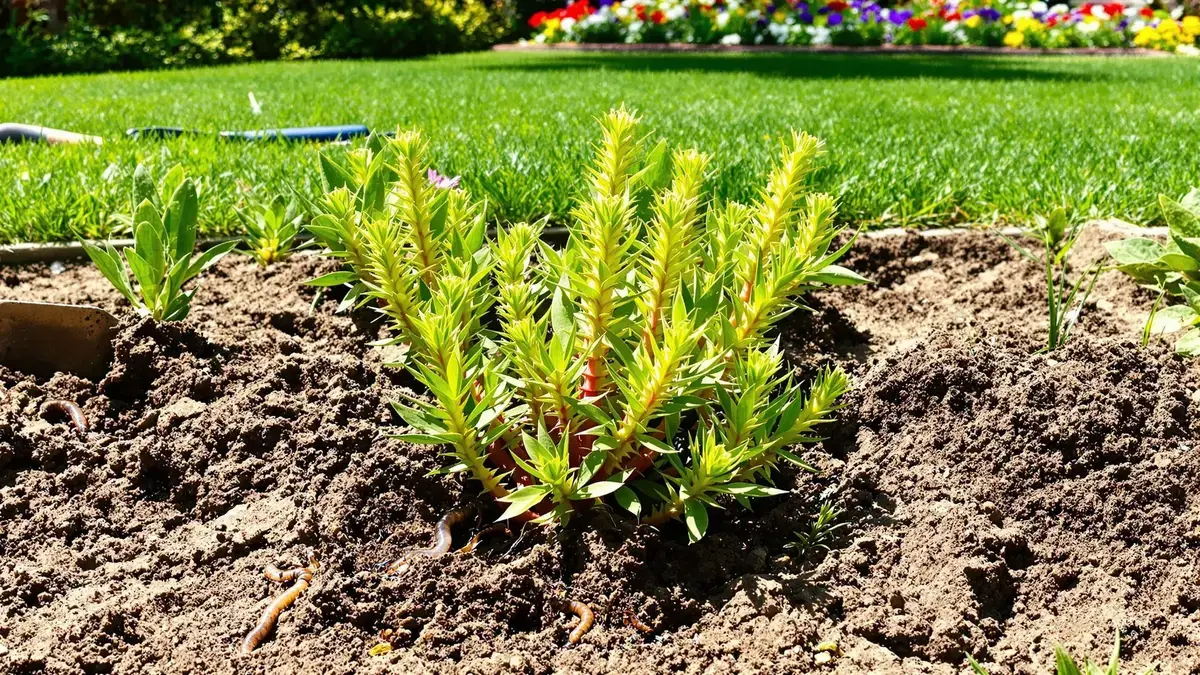Moles can quickly turn a garden into a true excavation site, leaving bothersome mounds of earth for gardeners. Attracted by fertile soil teeming with prey, their activity can disrupt the aesthetics and health of plants. However, the Mole Plant, or euphorbia lathyris, proves to be an effective solution, due to its irritating sap that deters these animals.
The essential information
- Moles create mounds of earth that annoy gardeners.
- They are attracted to fertile soil and aerate it by digging tunnels.
- The mole plant is an effective repellant plant to keep these pests away.
- There are other natural and physical methods to manage their presence humanely.
Moles turn the garden into an excavation site
Moles, those little excavators of nature, attack your gardens, transforming them into true excavation sites. These animals dig with terrifying efficiency, leaving behind mounds of earth that can frustrate gardeners. Each movement of this crafty soil creature primarily aims to aerate the ground, but for gardeners, these tunnels can quickly become an aesthetic and practical nightmare.
Annoying mounds of earth for gardeners
The mounds of earth formed by moles become a major source of irritation. Not only do they affect the aesthetics of the garden, but they also disrupt plant growth. By uprooting roots and altering the soil structure, these little creatures make the task of gardeners particularly challenging. Every mole is vital to the ecosystem, but their presence requires a certain level of adaptation from gardeners.
They dig tunnels to aerate the soil
However, the tunnels created by moles play an essential role in the garden. By aerating the soil, they promote drainage and allow better air and water circulation, which can be beneficial for plant roots. Thus, while gardeners may view the work of moles unfavorably, it should not be forgotten that these creatures also contribute to the natural balance of the garden.
Moles are attracted to fertile soil rich in prey
Moles do not dig randomly; they are attracted to rich, fertile soils where their food—primarily worms and other insects—is abundant. A well-maintained garden with fertile soil is therefore a true paradise for these animals. It is crucial to understand that combating moles requires improving soil management and considering wildlife-friendly methods.
The mole plant: an effective repellent
To counter the presence of moles, a natural and effective solution is the use of the mole plant, also known as euphorbia lathyris. This plant has a sap that, upon contact with moles, serves as a repellent. By incorporating this plant into your garden, you can effectively discourage these animals from settling and digging in your green space.
Its irritating sap deters moles, keeping them away
The irritating sap of the mole plant lies at the heart of its effectiveness. By experimenting with this plant, gardeners find a solution that does not harm the ecosystem while protecting their garden. This natural property is invaluable, as it allows you to keep your crops healthy without resorting to cruel or chemical methods.
Planting near lawns or flower beds
It is advisable to plant mole plant near lawns or flower beds. By creating a natural barrier, this plant helps deter moles from approaching the most popular areas of your garden. Its propagation and maintenance are also quite simple, making it an ideal candidate for environmentally conscious gardeners.
Minimal maintenance: moderate watering, adapts to various soils
One of the great qualities of the mole plant is its minimal maintenance. In fact, moderate watering is sufficient for its survival, and it adapts to different types of soil. This makes it an ideal option for novice gardeners or those who do not have much time to dedicate to maintenance. Choosing this plant means opting for a garden that is easy to manage while combating moles naturally.
Goodbye Weeds! A Landscaper’s Secret for a Low-Maintenance Garden
Combine with mint or tansy to strengthen the effect
To optimize the effect of the mole plant, gardeners can combine it with other plants like mint or tansy. These plants, known for their repellent properties, will reinforce the deterrent effect against moles and other pests. This synergy between different plantings can significantly impact the preservation of your garden.
Other methods: physical barriers, vibration probes
In addition to using repellent plants, other methods can be considered to manage the presence of moles. Among them, physical barriers or the installation of vibration probes create an environment that discourages moles from establishing themselves permanently. These devices, while requiring a lower investment, can prove effective in the fight against these creatures.
Natural products like pepper and white vinegar create a hostile environment
Gardeners can also resort to natural products like pepper and white vinegar to create a hostile environment for moles. These solutions are not only effective but also preserve the ecological integrity of the garden. By experimenting with different solutions, it becomes possible to manage the mole population without harming the overall ecosystem.
Experimenting with different solutions helps manage moles
Managing moles often requires a bit of experimentation. By trying various methods, from plant-based to mechanical, every gardener can discover what works best in their particular situation. It is essential to note that every garden is unique and that approaches should be tailored to each situation, without losing sight of the humane aspect of gardening.
Seeking to protect the garden humanely
In the effort to protect their garden, it is essential to look for solutions that do not harm moles. By opting for environmentally friendly methods, gardeners can maintain the natural balance while preventing these small creatures from causing damage. Ultimately, the key lies in a balanced approach, combining respect with effective garden management.













